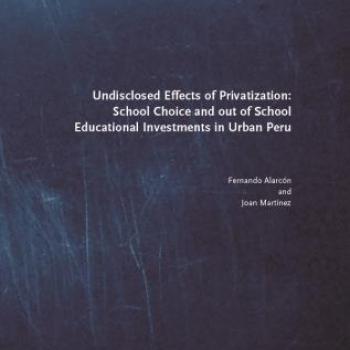
This study aims to evaluate the relationship between private school's attendance and student's allocation of time on educational activities outside school. In this sense, our analysis focuses on student's learning investments throughout their educational progress. We model parent's consumption decisions and private schooling choice to predict a positive relationship between children's educational investments at home and parents' welfare. Using this analytical framework we aim to interpret reduced form results. A main challenge to obtain consistent estimates on this relationship hinges on selection problems as is broadly depicted on school choice empirical literature. To overcome this, our identification strategy exploits the supply expansion of private schools in urban areas of Peru prompted by a nationwide market deregulation policy issued in 1997. Using data from the Young Lives Survey for Peru (Rounds 1, 2 and 3 from the younger and older cohort) we employ Ordinary Least Squares (OLS) and Instrumental Variables (IV) methods while controlling for students, school and family covariates. Our results indicate a positive relationship between private school attendance and educational investments outside school for the younger cohort of children of 8-9 years old at the time of the survey; but not for the older cohort of children aged 11-12 years old. We argue that the relationship dissipates as parents have less involvement on children's time allocation. IV results show a stronger linkage once we account for self-selection bias that arises from parents' school choice. As predicted in our model, parents compensate the loss of supervision time of their children's education due to working hours by enrolling them in private schools.

This study aims to evaluate the relationship between private school's attendance and student's allocation of time on educational activities outside school. In this sense, our analysis focuses on student's learning investments throughout their educational progress. We model parent's consumption decisions and private schooling choice to predict a positive relationship between children's educational investments at home and parents' welfare. Using this analytical framework we aim to interpret reduced form results. A main challenge to obtain consistent estimates on this relationship hinges on selection problems as is broadly depicted on school choice empirical literature. To overcome this, our identification strategy exploits the supply expansion of private schools in urban areas of Peru prompted by a nationwide market deregulation policy issued in 1997. Using data from the Young Lives Survey for Peru (Rounds 1, 2 and 3 from the younger and older cohort) we employ Ordinary Least Squares (OLS) and Instrumental Variables (IV) methods while controlling for students, school and family covariates. Our results indicate a positive relationship between private school attendance and educational investments outside school for the younger cohort of children of 8-9 years old at the time of the survey; but not for the older cohort of children aged 11-12 years old. We argue that the relationship dissipates as parents have less involvement on children's time allocation. IV results show a stronger linkage once we account for self-selection bias that arises from parents' school choice. As predicted in our model, parents compensate the loss of supervision time of their children's education due to working hours by enrolling them in private schools.

